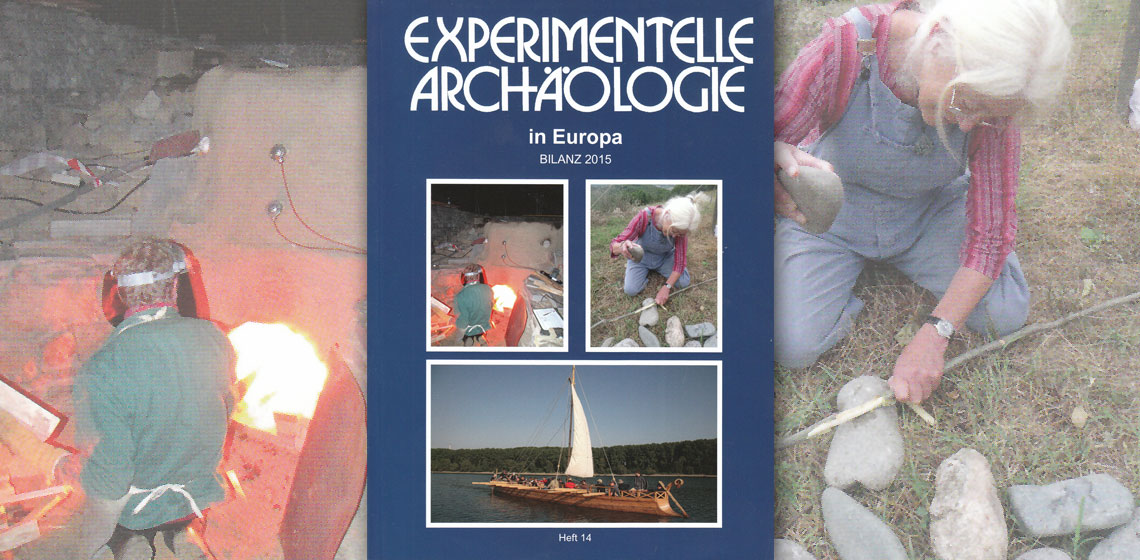
Volume number 14 of the periodical “Experimentelle Archäologie in Europa: Bilanz 2015” represents the proceedings of the 11th meeting of EXAR held in cooperation with the Labor für Experimentelle Archäologie (LEA), a branch of the Römisch-Germanischen-Zentralmuseums in Mainz (RGZM), in Mayen, Germany, in 2015.
It is published and prefaced by a foreword written by Professor Dr. Gunter Schöbel, president of the European Association for the Advancement of Archaeology by Experiment (EXAR), and consists of 237 pages with 21 different articles on a wide variety of subjects. The contributions are presented in three sections: Experimentation and Trials, Experimental Archaeology, and Theory and Didactic, as well as a section for short and annual reports.
The articles cover a broad spectrum from cooking over metallurgy to construction from the Neolithic into Late Antiquity and the late Middle Ages. They are directed at both a professional audience as well as the amateur archeologists, historical reenactors and living history interpreters. Although a German publication with contributions from German, Austrian, Swiss and British research teams, each article is prefaced with an abstract in English and the numerous colour photographs and other visual aids are labeled in both German and English.
Articles in this book cover a broad range of topics written in a very approachable style that makes their information accessible to a wide variety of readership. Colour photographs and other visual aids are included as well as bibliographies for further reading.
Just like previous issues of "Experimentelle Archäologie", this volume is a treasure for all who care about gaining a more practical, hands-on experience and a better understanding of history. It provides insight into a broad range of topics in a surprisingly accessible and easy to understand way without neglecting scholarly expertise and methods. The excitement and enthusiasm of the researchers is apparent in each article which renders the entire publication a captivating read for any archeology-inclined reader.
Article overview
Experimentation and Trials:
- Archaeometallurgical experiments an extracting copper from malachite in open fireplaces.
- Intentional or accidental? Fire impact on perforated stone axes from Niederwil
- From the side of the road into the pot! — A culinary experiment with lambs quarters and garlic mustard weeds
- The water flushing system of Roman latrines (a surprisingly fascinating article offering insight into the methodology of discovering the flushing mechanism of Roman latrines)
- Experimental Archaeological Studies on Roman Porridge. Report on the Methodological Approach of the First Laboratory Experiment”
- The lead kettles of Pompeii from a technical perspective
- Encaustic Painting in Ancient Rome
- The experimental Roman glass furnace project in the Archaeological Park Roman Villa Borg (Borg Furnace Project)
- The reconstruction of a battleship — understanding strategic changes at Roman riverine frontiers in Late Antiquity
The scope of included experiments, particularly the experiments relating to cooking and painting, are small scale allowing the amateur archeologist to recreate the experience.
Experimental Archeology:
- Making fire with the fire drill
- The reconstruction model of a Bronze Age warrior chariot according to archaeological findings from the Sintagta-Culture in Transural
- Reconstruction model of an idealized Late Bronze Age casting workshop in the Museum of Prehistory in Asparn in Lower Austria
- The antique stone turning lathe — a forgotten machine reconstructed
The scope of included experiments is less suitable for at-home experimentation but nonetheless fascinating and educational for even the most casual observer. I particularly found the article on stone turning lathes fascinating – stone lathes are indeed a forgotten, but most intriguing tool.
Theory and Didactics:
- Predictive experimental archaeology as a tool in the study of ancient mining and metallurgy (English language article)
- Zuku, busu, tersitu - The art of making colored glass
- Culina Historica — Archaeology and Cookbook Research
- The Language of Traces, Remains and X-ray Documentation — the Role of scientific Archaeological Conservation for the readability of Archaeological Metal-Objects
- Experimental Archaeology & Science 2.0: Perspectives for the Laboratory for Experimental Archaeology
- Selected Theses on quality assurance of costumed live interpretation (offers the living history interpreter and reenactor food for thought with regards to teachable moments and approach to sharing knowledge in a meaningful way)
Short/ Annual Reports and updates:
- Testing Neolithic tools for tree felling at Ergersheim Grafholz – tool bindings
- Annual report of the Europäischen Vereinigung zur Förderung der Experimentellen Archäologie (EXAR) for the year 2014 – retrospective, development, and future of EXAR
Book information:
Weller, U., Lessig-Weller, T., Hanning, E., Strugalla-Voltz, B., & Walter, P. (eds), 2015. Experimentelle Archäologie in Europa, Bilanz 2015, Heft 14, Bad Langensalza: EXAR, Unteruhldingen: Gunter Schöbel & Europäische Vereinigung zur Förderung der Experimentellen Archäologie e.V. European Association for the advancement of archaeology by experiment, ISBN: 978-3-944255-03-3.